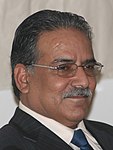User:Fudo Kun/sandbox
Appearance
Current Council of Ministers
[edit]On 15 February 2018, President Sher Bahadur Deuba appointed Nepali Congress Chairman Ram Chandra Paudel as the Prime Minister of Nepal.
 | |||||||||||||||||||||||||||||||||||||||||||||||||||||||||||||||||||||||||||
| |||||||||||||||||||||||||||||||||||||||||||||||||||||||||||||||||||||||||||
275 seats to the Nepalese House of Representatives 138 seats needed for a majority | |||||||||||||||||||||||||||||||||||||||||||||||||||||||||||||||||||||||||||
|---|---|---|---|---|---|---|---|---|---|---|---|---|---|---|---|---|---|---|---|---|---|---|---|---|---|---|---|---|---|---|---|---|---|---|---|---|---|---|---|---|---|---|---|---|---|---|---|---|---|---|---|---|---|---|---|---|---|---|---|---|---|---|---|---|---|---|---|---|---|---|---|---|---|---|---|
| Turnout | 78.34% | ||||||||||||||||||||||||||||||||||||||||||||||||||||||||||||||||||||||||||
| |||||||||||||||||||||||||||||||||||||||||||||||||||||||||||||||||||||||||||
| |||||||||||||||||||||||||||||||||||||||||||||||||||||||||||||||||||||||||||
| Gyanendra Shah | |||||
|---|---|---|---|---|---|
| King of Nepal | |||||
| Reign | 7 November 1950 – 7 January 1951 | ||||
| Coronation | 7 November 1950[1] | ||||
| Predecessor | Tribhuvan Bir Bikram Shah | ||||
| Successor | Tribhuvan Bir Bikram Shah | ||||
| Reign | 4 June 2001 – | ||||
| Coronation | 4 June 2001[2] | ||||
| Predecessor | King Dipendra | ||||
| Successor | incumbent | ||||
| Born | 7 July 1947 Narayanhiti Royal Palace, Kathmandu, Nepal | ||||
| Spouse | Queen Komal | ||||
| Issue | Prince Paras Princess Prerana | ||||
| |||||
| House | Shah Dynasty | ||||
| Father | King Mahendra | ||||
| Mother | Crown Princess Indra | ||||
| Religion | Hinduism | ||||
Federal Kingdom of Nepal
| |
|---|---|
| Motto: "Janani Janmabhumishcha Swargadapi Gariyasi (Sanskrit)" "Mother and Motherland Are Greater Than Heaven" | |
| Anthem: "Shreeman Gambhir" "May Glory Crown You, Courageous Sovereign" | |
 Land controlled by Nepal shown in dark green; land claimed but uncontrolled shown in light green. | |
| Capital and largest city | Kathmandu[3] 28°10′N 84°15′E / 28.167°N 84.250°E |
| Official languages | Nepali[4] |
| Recognised national languages | All mother-tongues |
| Ethnic groups (2011)[5] | |
| Religion (2011)[5] | |
| Demonym(s) | |
| Government | Federal constitutional monarchy |
• King | Gyanendra of Nepal |
| Ram Chandra Paudel[6] | |
| Legislature | Federal Parliament |
| National Assembly | |
| House of Representatives | |
| Formation | |
• Kingdom | 25 September 1768[7] |
| 4 March 1816 | |
| 21 December 1923 | |
| 20 September 2015 | |
| Area | |
• Total | 147,516 km2 (56,956 sq mi) (93rd) |
| Population | |
• 2011 census | 26,494,504[10] |
• Density | 180/km2 (466.2/sq mi) |
| GDP (PPP) | estimate |
• Total | <ref> tag is missing the closing </ref> (see the help page). |
| ISO 3166 code | NP |
- ^ "Nepal: King Tribhuvan and fall of the Ranas". 23 June 2009.
- ^ "New Nepalese King Gyanendra Crowned". Retrieved 8 September 2018.
- ^ "Nepal | Facts, History & News". www.infoplease.com. Retrieved 29 June 2020.
- ^ "Nepal | Culture, History, & People". Encyclopædia Britannica. Retrieved 29 June 2020.
- ^ a b 2011 National Census, p. 4.
- ^ Cite error: The named reference
officewas invoked but never defined (see the help page). - ^ Subba, Sanghamitra (20 December 2019). "A future written in the stars". Nepali Times. Archived from the original on 31 January 2021. Retrieved 31 January 2021.
- ^ The Sugauli Treaty of 1816 rendered moot the degree of independence of Nepal. The sixth point of the treaty directly questions the degree of independence of Nepal. The fact that any differences between Nepal and Sikkim will be "referred to the arbitration of the East India Company" sees Nepal as a semi-independent or a vassal state or tributary of the British empire.
- ^ Formal recognition of Nepal as an independent and sovereign state by Great Britain.
- ^ 2011 National Census, p. 1.


















